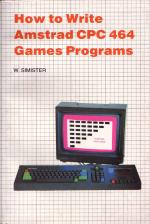
Computer Gamer
 1st September 1985
1st September 1985
Categories: Review: Book
Author: Jane Naylor
Publisher: Babani Books
Machine: Amstrad CPC464
Published in Computer Gamer #6
How To Write Amstrad CPC464 Games Programs
If you have had an Amstrad for a few months and are looking for some ideas on creative programming now that you have taken your first tentative steps in Basic, you might find How To Write Amstrad CPC464 Games Programs worth looking at.
The author aims to teach beginners some of the fundamental tricks and routines of games programming, while at the same time demonstrating them practically in a few selected programs throughout the book. It is a nice idea and it works well.
There is one major limitation however: only a limited area of games is discussed, board and card games. So if you were hoping for hints on shooting down aliens or creating limitless scenarios for adventure games, this is not the book for you and to this extent I feel the title is somewhat misleading. There is certainly nothing wrong with board games in themselves, but the fact that the book concentrates on this should be made more obvious to the buyer.
Within this area, the subject is covered very well. You are shown how to write a game of Patience, draughts, reversi, Go, chess and a few other well-known favourites. The routines are carefully explained and demonstrated so you should then be able to go on and create your own variations, having mastered such intricacies as creating UDGs, LOCATEing text on the screen at certain positions, selecting colours and simulating the throwing of a dice.
Seven games programs are included in the book, each of a reasonable length for typing in, so you get pretty good value for money packed into these 134 pages.
One aspect which I feel could have been improved upon - though no doubt it would have increased the price - is the presentation. Some of the routines are complicated to explain and understand initially and the very densely packed text in this small book does not help. Single program lines would have been better picked out of the text so they could be clearly seen for typing in, and a few subheadings would have broken up the chapters a bit, especially where several different points are covered. I also feel that it would have been useful to include some screenshots to illustrate the effect that is being explained.
Overall, this is a useful read for Amstrad owners and will be particularly interesting to board and card game enthusiasts. It introduces some elementary programming concepts in a lively and readable way, while, at the same time, providing many useful skeleton routines and some full blown programs.
Scores
Amstrad CPC464 Version| Overall | 77% |


